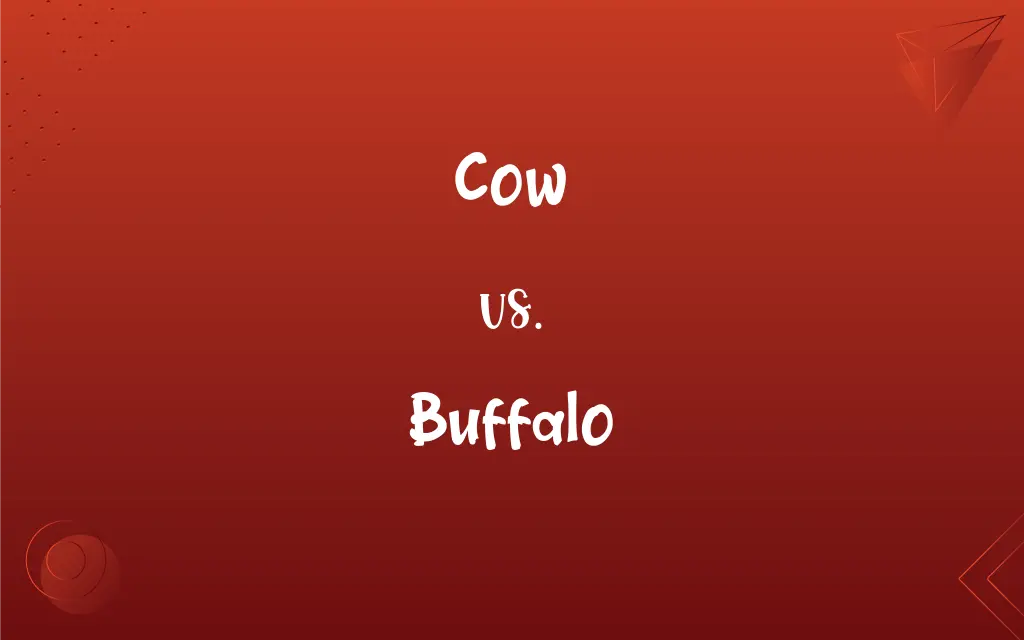Cow vs. Buffalo: What's the Difference?
Edited by Harlon Moss || By Janet White || Published on December 6, 2023
Cows are domesticated animals with varied breeds for milk and meat, while buffaloes are larger, wild or domesticated, used mainly in agriculture and dairy.

Key Differences
Cows, known for their docility, are a staple in dairy and meat industries globally. Buffaloes, in contrast, are renowned for their strength and are integral to both dairy and agricultural sectors, especially in Asia.
The physical appearance of cows varies widely among breeds, yet they typically have a gentler demeanor. Buffaloes, distinguishable by their larger size and robust horns, have a more rugged appearance and are adapted to a variety of environments.
In terms of dairy production, cows produce milk that is high in butterfat, making it ideal for butter and cheese production. Buffalo milk, however, has higher fat content and is a key ingredient in specialized dairy products like mozzarella.
The role of cows in cultural and religious contexts cannot be overstated, with certain breeds revered in many societies. Buffaloes, while also culturally significant in some regions, are primarily valued for their labor and agricultural contributions.
The adaptation of cows to various climates is notable, making them ubiquitous in farming globally. Buffaloes, particularly water buffaloes, are more prevalent in tropical and subtropical regions, showcasing a different ecological adaptability.
ADVERTISEMENT
Comparison Chart
Domestication
Primarily domesticated
Both wild and domesticated
Use
Dairy, meat, cultural
Agriculture, dairy, labor
Physical Traits
Smaller, varied breeds
Larger, robust, strong horns
Milk Properties
High in butterfat
Higher fat content
Cultural Role
Revered in many cultures
Valued for labor and dairy
ADVERTISEMENT
Cow and Buffalo Definitions
Cow
An adult female of the cattle species.
The cow in the field is expecting a calf soon.
Buffalo
To confuse or deceive.
The complex instructions completely buffaloed him.
Cow
Used colloquially to describe a large or cumbersome object.
Moving that sofa was like maneuvering a cow.
Buffalo
A heavily built wild ox with backswept horns.
The buffalo roamed freely across the plains.
Cow
A domesticated bovine animal kept for milk or meat.
The farmer milks the cow every morning.
Buffalo
Pertaining to the city of Buffalo in New York.
She's traveling to Buffalo for a conference.
Cow
To intimidate or bully someone into submission.
He tried to cow his opponent with fierce rhetoric.
Buffalo
Used to describe tough or rugged individuals.
He's as strong as a buffalo in character and physique.
Cow
In informal usage, refers to an unpleasant or disliked woman.
She was called a cow by her spiteful neighbor.
Buffalo
Refers to the water buffalo, an Asian domesticated animal.
The water buffalo is essential for plowing fields in that region.
Cow
The mature female of cattle of the genus Bos.
Buffalo
Any of several large African and Asian ruminant mammals of the family Bovidae, such as the water buffalo and the African buffalo.
Cow
The mature female of certain other large animals, such as elephants, moose, or whales.
Buffalo
The American bison (Bison bison).
FAQs
Are buffaloes domesticated or wild?
Buffaloes can be both; some are domesticated for farm use while others remain wild.
What is a cow?
A cow is a domesticated bovine animal, often kept for dairy or meat.
Can cows survive in various climates?
Yes, cows are adaptable to a variety of climates worldwide.
What are the main uses of buffaloes?
Buffaloes are used for dairy production, agricultural labor, and sometimes for meat.
How does buffalo milk compare to cow's milk?
Buffalo milk has a higher fat content and is used in specific dairy products.
What is the lifespan of a cow?
Cows generally live for about 15-20 years.
What are the different breeds of cows?
There are numerous cow breeds, including Holstein, Jersey, and Angus.
What is unique about cow's milk?
Cow's milk is known for its butterfat content, ideal for dairy products like cheese.
What physical traits differentiate a buffalo?
Buffaloes are larger, with robust bodies and distinctive horns.
Do cows have cultural significance?
Yes, cows are revered in many cultures for religious and symbolic reasons.
Are cows social animals?
Yes, cows are known to be social and often form close relationships within herds.
Are there different types of buffaloes?
Yes, including the water buffalo and African buffalo, each adapted to different environments.
Is buffalo milk richer than cow's milk?
Yes, buffalo milk is richer in fat and protein compared to cow's milk.
What are the environmental needs of cows?
Cows require pasture for grazing, water, and shelter from extreme weather.
How long do buffaloes live?
Buffaloes have a similar lifespan to cows, around 15-25 years.
Do buffaloes display social behavior?
Buffaloes also exhibit social behavior, living in herds with a hierarchy.
What is the role of buffaloes in agriculture?
Buffaloes are used for plowing fields and other labor-intensive agricultural tasks.
Can cows be trained?
Cows can be trained for basic tasks and often respond to human interaction.
Are buffaloes used in sports or entertainment?
In some cultures, buffaloes are used in traditional sports and ceremonial events.
How much milk does a cow produce daily?
A cow's daily milk production varies, but can average around 6-7 gallons.
About Author
Written by
Janet WhiteJanet White has been an esteemed writer and blogger for Difference Wiki. Holding a Master's degree in Science and Medical Journalism from the prestigious Boston University, she has consistently demonstrated her expertise and passion for her field. When she's not immersed in her work, Janet relishes her time exercising, delving into a good book, and cherishing moments with friends and family.
Edited by
Harlon MossHarlon is a seasoned quality moderator and accomplished content writer for Difference Wiki. An alumnus of the prestigious University of California, he earned his degree in Computer Science. Leveraging his academic background, Harlon brings a meticulous and informed perspective to his work, ensuring content accuracy and excellence.


































































